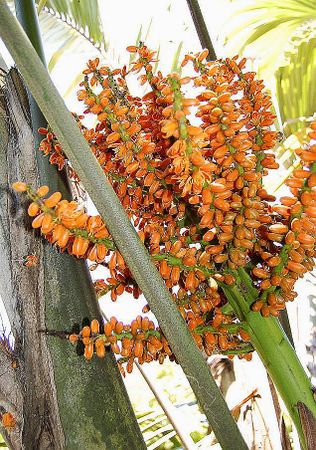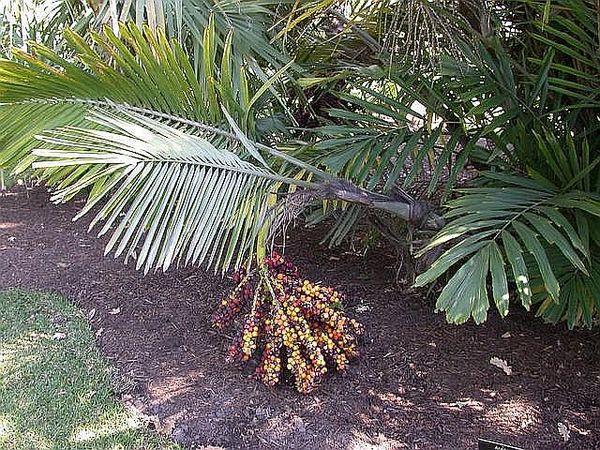Arenga engleri
| Arenga (ah-REN-gah) engleri (eng-LEHR-ee) | ||||||||
|---|---|---|---|---|---|---|---|---|
 Florida | ||||||||
| Scientific Classification | ||||||||
| ||||||||
| Synonyms | ||||||||
|
| ||||||||
| Native Continent | ||||||||
|
| ||||||||
| Morphology | ||||||||
| ||||||||
| Culture | ||||||||
| ||||||||
| Survivability index | ||||||||
| ||||||||
| Common names | ||||||||
|
| ||||||||
Contents
Habitat and Distribution
The Formosa palm is native to islands south of Japan, including Taiwan (Formosa) and the Ryukyu Islands. It also has been reported from India. The Formosa palm occurs on slopes in dense forests.Description
Arenga engleri, the Formosa palm, radiates a tropical beauty and is considered to be among the finest landscape and cultivated palms. This attractive clustering palm rarely grows more than 10 ft (3.1 m) tall with a stem diameter of 6 in (15.2 cm) and a spread up to 16 ft (4.9 m). The stems are cloaked with delicate black fibers. The Formosa palm has long graceful triangular fishtail-shaped (pinnate) leaves up to eight feet long. The dark olive-green leaves often twist gracefully, giving them a slight spiraling appearance. Leaflets spring from the midrib of each thornless stem, and are dark-green to olive on their topside, and silvery beneath. The 5-8 in (12.7-20.3 cm) long leaflets have an unusual and distinctive V (induplicate) cross-section and grow abundantly in a single plane off the stems. The spike like flower stalks are borne among the leaves and have both male and female flowers, so a single Formosa palm can produce fertile seeds by itself. The red, orange or green flowers have a sweet fragrance and produce red to deep purple fruits. Each globular fruit is less than 1 in (2.5 cm) in diameter and contains one to three seeds. Editing by edric.
Culture
Culture, In its native environment, the Formosa palm enjoys moist soil and is tolerant of poor soils that have good drainage. The Formosa palm thrives in rich, humusy and slightly acidic soils. For best results, the soil should be kept uniformly moist, not wet, and should have excellent drainage. The Formosa palm responds exceptionally well to applications of fertilizer and can grow reasonably quickly to a magnificent landscape subject. Formosa palm is not tolerant of salt, salt spray or high winds. Light: The Formosa palm does well in semi-shade lighting. Some enthusiasts also report excellent success with Formosa palms in sunny, sheltered gardens. Smaller Formosa palms need protection from excess sun. Moisture: Formosa palm thrives in rich soils that are thoroughly moist and have excellent drainage. The Formosa palm is not drought tolerant. Hardiness: USDA Zones 8B - 11. The Formosa palm is considered extraordinarily adaptable and easy to cultivate. Mature and established plants can tolerate temperatures down to about 15- 25ºF (-9.4 - -3.9ºC)for short periods. To ensure maximum cold hardiness it is recommended that the Formosa palm be planted in a protected understory. The small size of the Formosa palm lends easily to being planted under a grove of trees or other protection. Propagation: The Formosa palm is propagated from seeds. Formosa palm seeds are considered to have maximum viability for germination if they are planted no more than 4-6 weeks after the fruit has become ripe. Seeds have a wide range of germination times; some seeds may germinate very quickly, while others may take two years to sprout! Propagation also can be accomplished by division and removal of suckers but these may be slow to establish.

Surprisingly this palm is one of the most cold hardy pinnate palms in the world. But alas, it is monocarpic so the flowering stalk dies after setting seed. However, there are always plenty of new suckers to replace it.
Comments and Curiosities
The flowers have a very pleasant fragrance. Fruit is both caustic, and poisonous.
Phenology: Flowers in May and June.
- IMAGE GALLERY
"Last week I got an early morning tour of the landscape at Disney's Animal Kingdom. This is in the new 14 acre Pandora section. It is based on the Avatar movie. They have done a spectacular job with the landscaping using many, many unusual and odd plants. They have also added "fake" alien plants and the blend is seamless. The detail of this park is just incredible. In addition to the Caryota obtusa (they planted over 200 of these) which I posted in a separate post, they planted some other nice palms and most aren't the common specimens found here. Bismarckia nobilis, most of these were 25-30ft tall and several were green forms". Arenga engleri. Orlando, FL. Photo by H.P. Leu Gardens Botanist Eric S.
External Links
- Glossary of Palm Terms
- MODERN BOTANICAL LATIN
- "Just To Be Clear"
- http://itp.lucidcentral.org/id/palms/palm-id/Arenga_engleri.htm
- Click on Arecacaea, for list of photos
References
Phonetic spelling of Latin names by edric.
Special thanks to Geoff Stein, (Palmbob) for his hundreds of photos.
Special thanks to Palmweb.org, Dr. John Dransfield, Dr. Bill Baker & team, for their volumes of information and photos.
Glossary of Palm Terms; Based on the glossary in Dransfield, J., N.W. Uhl, C.B. Asmussen-Lange, W.J. Baker, M.M. Harley & C.E. Lewis. 2008. Genera Palmarum - Evolution and Classification of the Palms. Royal Botanic Gardens, Kew. All images copyright of the artists and photographers (see images for credits).
Many Special Thanks to Ed Vaile for his long hours of tireless editing and numerous contributions.




















































